|
Hologram News part just showes the updated Hologram Technology and Hologram News in the world to any reader. All news are from Internet and newpaper. This is not for commercial purpose. If there's mistake, please contact us to correct it.
1.. Let There Be Light, in Three Dimensions from http://www.nytimes.com/2012/08/24/arts
Despite C. P. Snow’s 1959 plaint about the gap between science and the humanities, there isn’t any — on one level at least. Artists happily take up whatever new technology falls into their hands. The mystery is why some inventions gain traction and others, like holograms, are met with a flurry of excitement, used for a short time and then abandoned.
The current silence around holograms — “Pictures From the Moon” at the New Museum could easily be titled “Remember Holograms?” — is particularly interesting. Fifteen years after the discovery of holography by the physicist Dennis Gabor in 1947 actual holograms were made possible with the development of laser technology in 1962. A hologram is created when a laser beam is split, with one part of the beam reflected off an object onto a photographic plate and the other part projected directly onto the plate; the interference among light waves from the two beams creates the image. (Mr. Gabor’s invented term came from the Greek words “holos,” for whole or entire, and “gramma,” for picture or message.)

Artists jumped on the technology in the mid-1960s, and a Museum of Holography was founded on Mercer Street in SoHo in 1976, with a first exhibition that went on to travel around the world for more than a decade. But then digital technologies eclipsed the medium, and holography got downgraded to mass-production status: key chains, jewelry and magazine covers, later postage stamps and credit card logos. (The Museum of Holography closed in 1992.)
As the New Museum’s installation demonstrates, art holograms are finicky beings. Like orchids or certain animal companions, they take up space and demand particular lighting. They also rely on the viewer to move in front of the image to create the illusion of the hologram’s three-dimensionality.
The earliest work here is Bruce Nauman’s “Hologram H” (1969) from his “Second Series: Full Figure Poses (A-J).” Mounted on a pedestal several feet from the wall, the hologram, on a glass plate, is illuminated from above and behind with a blood-red light. The theatrical lighting, combined with the absurd pose of the subject (Mr. Nauman himself) leaning forward to grab his foot, creates something akin to a performance of a Samuel Beckett play, but with a figure appearing and disappearing as you watch.

A more recent work, Chuck Close’s “Untitled #4” (1997/2007), also hinges on the uncanniness of the human body, seen here in three dimensions with every pore and ear hair visible, but also appearing and disappearing as you move in front of it. Mr. Close, the most celebrated artist of the otherwise moribund movement of photo- and hyperrealists from the ’70s, uses holography to perfect, creepy effect. (He has also worked with daguerreotypes, one of the earliest forms of photography, which likewise reproduce an astonishing degree of detail.)
Abstraction and color are the focus in Eric Orr’s four untitled holograms from 1995 and James Turrell’s “Untitled (22NSGB)” (2008). Mr. Orr’s works feature vertical planks of color hovering in complementary color fields, a bit like a 3-D Blinky Palermo painting except that the color planes move like louvered blinds as you pass in front of them. Mr. Turrell’s work, like his larger light installations, involves color represented in ethereal, geometrically abstract form; its two curved triangles appear to merge with each other and the space around them.
The other four works are by Ed Ruscha and Louise Bourgeois. The pair by Mr. Ruscha, “The End #1” and “The End #2” (both 1998/2007), replicate in three dimensions the two on-screen words that mark the end of a film. Ms. Bourgeois’s untitled deep red holograms from 1998 depict empty chairs suggestive of dollhouse furniture, one on a pedestal under glass, that fit with her lifelong project of undomesticating the accouterments of domestic life.

“Pictures From the Moon,” which was organized by Jenny Moore, an associate curator at the New Museum, is an adjunct to “Ghosts in the Machine,” the museum’s main exhibition, which explores the conjunctions of midcentury art, technology and humanity (although that show’s approach is framed somewhat more poetically as the “dreamlike life” shared by humans and machines).
But “Pictures From the Moon” is really more of a teaser than a full-blown show; it leaves you wanting a much broader treatment of the subject, which includes the pioneers and practitioners mentioned in the wall text: Margaret Benyon, Rudie Berkhout, Jody Burns, Harriet Casdin-Silver and Dieter Jung. (Other artists who dabbled in holograms include Salvador Dalí, Simone Forti, Michael Snow and Stan VanDerBeek, whose “Movie-Drome” of 1963-66 is one of the highlights of “Ghosts in the Machine.”)
The show is skewed instead toward well-known artists who used holography and toward works made well after its heyday. But there is no question that holograms aptly demonstrate the quasi-mystical relationship humans have with technology — and photography in particular, which has often been harnessed to represent the supernatural. (Holograms are not unlike 19th-century ghost photography and ectoplasm experiments, and there’s also a wax-museum chilliness to them that conjures a long history of photographing the dead.) No surprise, then, that holography inspired artworks and a dedicated museum or that it was quickly stifled into bureaucratic forms, like the postage stamp, or sublimated onto the already addictive medium of the credit card.
“Pictures From the Moon: Artists’ Holograms 1969-2008” continues through Sept. 30 at the New Museum, 235 Bowery, at Prince Street, Lower East Side; (212) 219-1222, newmuseum.org.
Hologram classifications There are three important properties of a hologram which are defined in this section. A given hologram will have one or other of each of these three properties, e.g. we can have an amplitude modulated thin transmission hologram, or a phase modulated, volume reflection hologram. it is made up of virtual systems.
Rainbow holograms Rainbow hologram showing the change in colour in the vertical direction
In this method, parallax in the vertical plane is sacrificed to allow a bright well-defined single colour re-constructed image to be obtained using white light. The rainbow holography recording process uses a horizontal slit to eliminate vertical parallax in the output image. The viewer is then effectively viewing the holographic image through a narrow horizontal slit. Horizontal parallax information is preserved but movement in the vertical direction produces colour rather than different vertical perspectives.[40] Stereopsis and horizontal motion parallax, two relatively powerful cues to depth, are preserved.
The holograms found on credit cards are examples of rainbow holograms. These are technically transmission holograms mounted onto a reflective surface like a metalized polyethylene terephthalate substrate commonly known as PET.
How hologram color been made?
Holograms are shooted by laser beam in different angles which figure out different colors - red, green, blue, yellow, etc, in difference viewing angles. C olors of the hologram will change, because when rainbow hologram is turned back and forth depending on the light source and viewing angle, the colors will run through the spectrum - the colors of the rainbow.
Different viewing depth of hologram comes from different position of the artwork film we locate when shooting master. Dot-matrix movement efffect comes from countinous hologram dots.
How does design show hologram color?
Holograms artwork design are basically an illusion; they are reflections of light that fool the eye into seeing a three-dimensional image. Therefore, it is impossible to give an accurate representation of a holographic image on a computer screen or paper printout. What you will receive via email or hardcopy is an artwork proof to look over to be sure that the graphics and layout are to your liking, free of typos, etc. The holographic master shooting process involves many detailed steps, so it is very important that all hologram artwork is approved before the project moves into the laser lab for holographic mastering.
How to make artwork for holographic sticker?
Holograms can be made from photos, flat art which is designed by Corel Draw, Illustrator, Photoshop or other software.Artwork file in Corel Draw or Illustrator format is best file for us to seperate overlay design into layers and colors. Adobe Photoshop file, JPG, GIF, is ok, if you cannot design by Corel Draw or Illustrator. The text in artwork file should be converted into curves, so we can open it without change font in it.
Design and sample photo:
A. 2D/3D, size 19mm*19mm, square, three layers, six color
  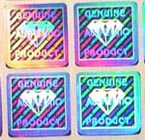
It has three layers, foreground, background and floating layer. There're three color on foreground, two color in background and one color in floating layer. So it has six colors and three layers.
B. 2D/3D, size 20mm in dia, circle, two layers, two color
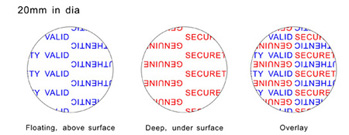  
It has two layers, floating layer and background layer. There're one color on foregroundfloating layer and one color in background layer. So it has two colors and two layers.
C. 2D/3D, size 25mm in dia, circle, two layers, 4 color
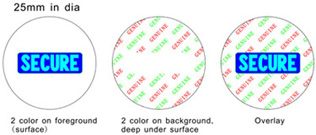  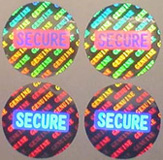
It has two layers, foreground layer and background layer. There're two color on foreground layer and two color in background layer. So it has four colors and two layers.
D. 2D/3D, size 30mm*14mm, rectangle, two layers, four color
  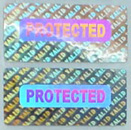
It has two layers, foreground layer and background layer. There're two color on foreground layer and two color in background layer. So it has 4 colors and two layers.
E. 2D/3D, size 25mm*25mm, square, threelayers, four color
  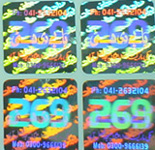
It has three layers, foreground, background and floating layer. There're two color on foreground, one color in background and one color in floating layer. So it has four colors and three layers.
F. 2D/3D, size 20mm*20mm, square, two layers, four color
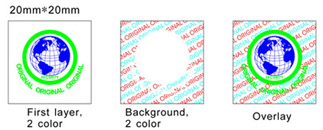  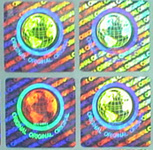
It has two layers, foreground layer and background layer. There're two color on foreground and two color in background layer. So it has four colors and two layers
G. 2D/3D, size 24mm*14mm, rectangle, three layers, three color
  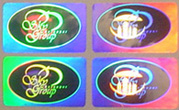
It has three layers, foreground, background and floating layer. There're one color on foreground, one color in background and one color in floating layer.
H. Dot-matrix & 2D/3D, size 30mm*15mm, rectangle, four flips
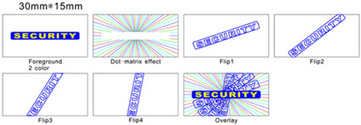  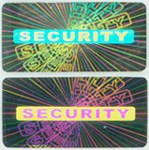
It has one layer. There're two 2D color on surface. dot-matrix effect lines make rotating light effect. Four flips of 'SECURITY' also make flips like a movie clips which shows each flip in different view angle.
I. Dot-matrix & 2D/3D, size 14mm in dia, circle, one layer
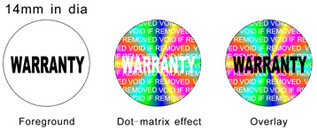  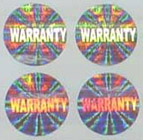
It has one layer. There're one color 2D text 'WARRANTY' and rotating dot-matrix effect on foreground
J. Dot-matrix & 2D/3D, size 20mm*20mm, square, three layers
  
It has three layers, foreground, background1 and background2. There're one color on foreground, background1 in second layer is image of pyramid and background2 in third layer is image of desert.
K. Dot-matrix & 2D/3D, size 30mm*30mm, sqaure, two layers
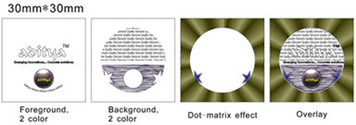  
It has two layers. There're 2 color 2D image on foreground, 2 color 2D image in background and dot-matrix effect on foreground.
L. Dot-matrix, 15mm*15mm, square
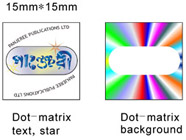  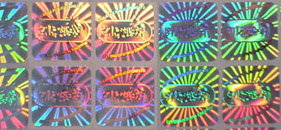
It has one layer. All images are made by Dot-matrix. The text and star is Dot-matrix type, not 2D type. The rotating light effect like sun also is Dot-matrix effect.
M. 2D/3D & Dot-matrix, size 25mm*15mm, rectangle
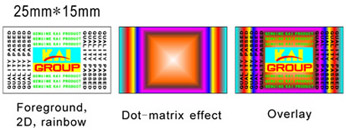  
It has one layer. There're 3 color 2D images and dot-matrix effect on foreground .
N. Dot-matrix & 2D/3D, size 15mm*25mm, rectangle, two layers
   It has two layers. There're photo, text and rainbow effect on foreground and one color text in the background layer. It has two layers. There're photo, text and rainbow effect on foreground and one color text in the background layer.
O. Dot-matrix & 2D/3D, size 25mm*15mm, rectangle
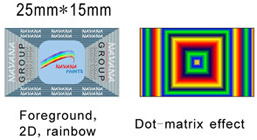  
It has one layer. There're 2 color text and rainbow image and dot-matrix effect on foreground.
P. Dot-matrix & 2D/3D, size 20mm*40mm, rectangle, three layers
  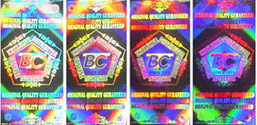
It has three layers. There're three color on foreground, two color in background deep and one color in floating layer. There's dot-matrix effect on foreground.
Q. 2D/3D, size 48mm*17mm, special shape
  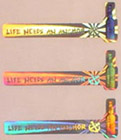
It has one layer. There're one color 2D text, one bottle image and dot-matrix effect on foreground.
R. 2D/3D, size 20mm in dia, circle, two layers
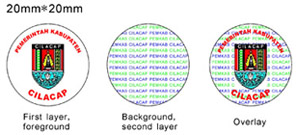  
It has two layers. There're one color 2D text and image of shield on foreground and two color text in background.
E-beam hidden text and Mole hidden text:
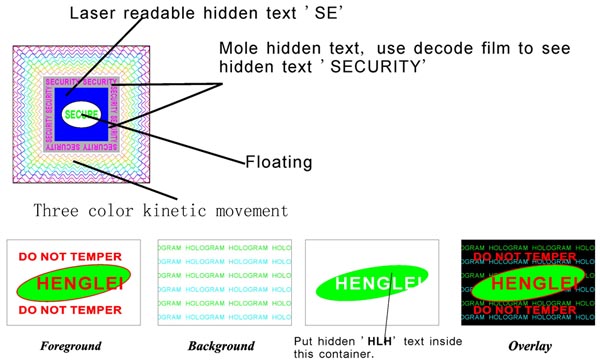
2D/3D hologram artwork sample:
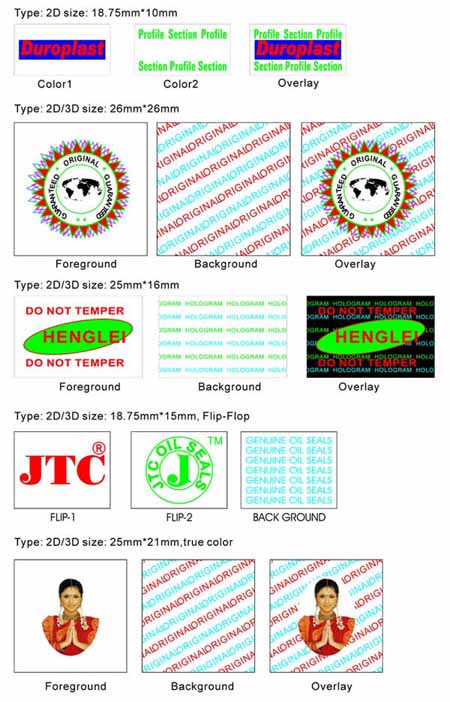
dot-matrix effect artwork sample:
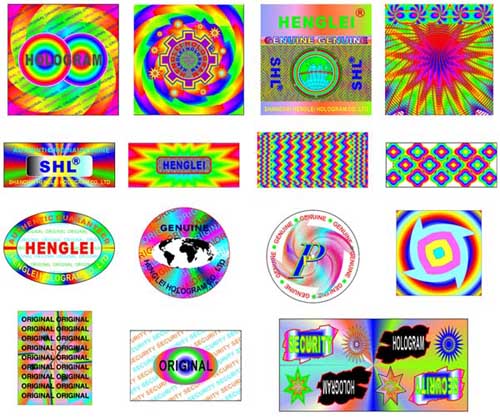
|































 It has two layers. There're photo, text and rainbow effect on foreground and one color text in the background layer.
It has two layers. There're photo, text and rainbow effect on foreground and one color text in the background layer. 










 07000688
07000688